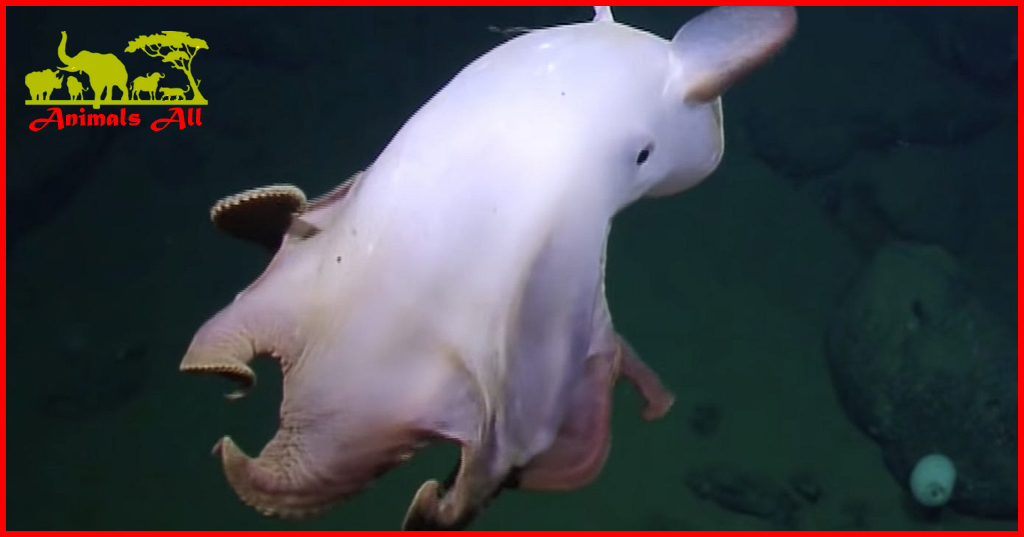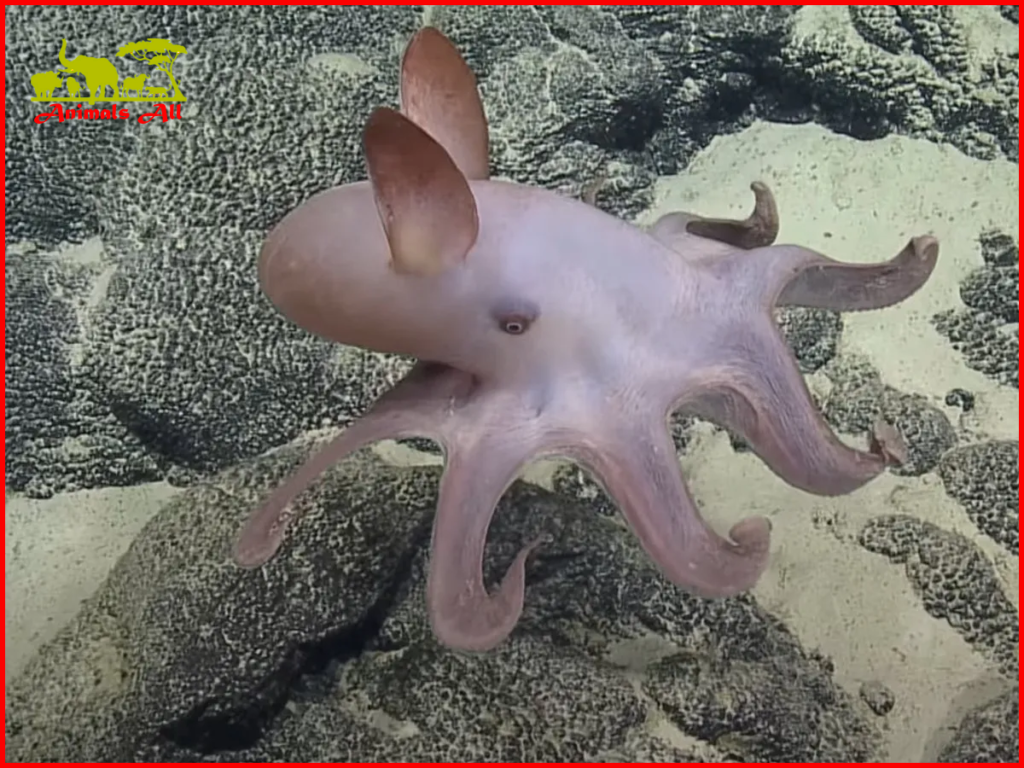
Dumbo Octopus: 5 Surprising Facts You Need to Know
The Dumbo octopus, also known as the deep-sea umbrella octopus, is a fascinating creature that lives in the depths of the ocean. With its unique features and captivating appearance, this mysterious species has caught the attention of scientists and ocean enthusiasts.
Imagine a creature with ear-like fins gracefully swimming through the dark waters, its partially see-through body glowing with lights it produces itself. This is the Dumbo octopus, a true wonder of nature. And while it may seem like something from a fantasy movie, this deep-sea creature is very much real.
Scientifically called Grimpoteuthis, the Dumbo octopus belongs to a group that includes over 13 known species. These amazing creatures can be found in different parts of the world’s oceans, from the Arctic to the Antarctic and everywhere in between.
Writing about the Dumbo octopus allows us to explore the mysteries of the deep sea and learn about the incredible adaptations that help these creatures survive in such harsh environments. So let’s discover some surprising facts about this extraordinary creature!
Unusual Appearance of the Dumbo Octopus
The Dumbo octopus has a fascinating look with its ear-like fins and partially see-through body. These special physical features are essential for its survival in the deep ocean. The ear-like fins, resembling those of the famous Disney character Dumbo, help it move gracefully through the water, navigating effortlessly. And the semi-translucent body acts as camouflage, allowing the Dumbo octopus to blend in perfectly with its surroundings and easily escape from potential predators.

These unique adaptations not only help the Dumbo octopus thrive in its natural habitat but also fascinate researchers and fans alike with their extraordinary beauty and practicality.
2. Deep-Sea Dweller: Habitat and Behavior
The Dumbo octopus, belonging to the Grimpoteuthis genus, lives in the deep ocean, specifically adapting to the ocean floor as its preferred home. It uses suction cups to move around and catch its prey, making it well-suited for its environment. These unique traits help the Dumbo octopus survive and thrive in the harsh conditions of the deep sea. For a more detailed understanding of how these fascinating creatures navigate and adapt in their habitat, you can refer to this scientific supplement.
Surprising Feeding Habits of the Dumbo Octopus
The Dumbo octopus has a fascinating feeding strategy that revolves around capturing small, elusive prey in the deep ocean. This unique creature primarily feeds on copepods, bristle worms, and other small marine organisms. These tiny prey are well-suited to the Dumbo octopus’s feeding habits due to their abundance in the deep-sea environment.
The Dumbo octopus captures its prey by:
- Utilizing its tentacles and suction cups
- Navigating the ocean floor with precision
Its feeding strategy is perfectly adapted to seizing these elusive food sources, showcasing the remarkable capabilities of this deep-sea dweller.
An image depicting a Dumbo octopus feeding on its prey vividly illustrates this extraordinary feeding behavior, providing a glimpse into the intriguing world of deep-sea survival and predation.
4. Reproduction Secrets in the Deep Ocean
The Dumbo octopus has a unique way of reproducing that sets it apart from its shallow-water counterparts. Unlike most shallow-water octopus species that have babies once and then die shortly after, the Dumbo octopus keeps laying eggs continuously, even in the challenging environment of the deep ocean. This continuous way of having babies is crucial for the survival of the species in their deep-sea home, where conditions are vastly different compared to shallower waters.
When we compare how the Dumbo octopus reproduces to how shallow-water octopus species do it, we can observe some fascinating differences in their strategies. While shallow-water octopuses put a lot of effort into one big reproductive event, Dumbo octopuses have adapted to keep producing offspring regularly instead of just once, as detailed in this National Academies article.
This difference in reproductive behavior signifies how these two types of octopuses have evolved differently when it comes to having babies. In fact, some mating strategies found in the deep ocean are so unique that they have been documented in this insightful Forbes article.
The deep ocean presents numerous challenges for any creature, including the Dumbo octopus. However, their continuous egg-laying strategy works well for them in this environment due to several reasons:
More
- Environmental Conditions: The deep sea harbors extreme cold, high pressure, and low oxygen levels. By continuously laying eggs, the Dumbo octopus increases its chances of having some offspring survive in such harsh conditions.
- Predation Risks: In the deep ocean, there are different predators compared to shallow waters. Continuous egg-laying helps the Dumbo octopus offset the higher risks of predation by ensuring that even if some eggs or young ones get eaten, there are always more being produced.
This unique way of reproducing shows us how the Dumbo octopus has evolved special traits to not just survive but thrive in its deep-sea habitat.
5. Ongoing Research and Conservation Efforts
Scientists are continuously studying the Dumbo octopus to learn more about this mysterious deep-sea creature. One group of researchers, known as the Nautilus Live scientist team, has been using remotely operated vehicles (ROVs) to capture videos and images of the Dumbo octopus and other deep-sea organisms.
- Their research has revealed valuable information about the behavior, habitat, and unique features of the Dumbo octopus.
- By studying these creatures, scientists have gained insights into their reproduction, diet, and interactions with other deep-sea animals.
- These findings are important for understanding how the Dumbo octopus fits into its deep-sea environment.
One interesting discovery made by the Nautilus Live scientists is that Dumbo octopuses can use their ear-like fins to swim through the water, contrary to previous beliefs that they only use them to hover near the ocean floor. This new knowledge emphasizes the need for further research to uncover more secrets about these fascinating creatures.
Conserving deep-sea ecosystems is crucial for protecting the habitats where the Dumbo octopus lives. Organizations like BOEM (Bureau of Ocean Energy Management) are working to safeguard these areas from potential dangers such as deep-sea mining and oil drilling. By supporting these organizations and raising awareness about the importance of preserving deep-sea environments, we can all play a part in protecting not just the octopus but also many other unique species in these delicate ecosystems.
Both research and conservation efforts are essential in ensuring the long-term survival of the Dumbo octopus and maintaining the fragile balance of our oceans. Through continued exploration and preservation of their habitats, we can uncover more mysteries about these captivating creatures while working towards a sustainable future for our planet’s deep-sea ecosystems.
Appreciating the Enigma of the Dumbo Octopus
The Dumbo octopus is a fascinating and mysterious creature that captures the interest of scientists and ocean lovers. Its distinct features, deep-sea home, and intriguing actions make it both inspiring and curious. As we explore more about this incredible species, we are reminded of how vast and amazing our oceans are.
1. Unique Appearance
The Dumbo octopus gets its name from its resemblance to the Disney character, Dumbo the elephant. It has ear-like fins on either side of its head, which it flaps to move gracefully through the water. These fins, along with its semi-translucent body, give it a distinctive appearance unlike any other octopus species.
2. Deep-Sea Habitat
Unlike most octopuses that live in shallow waters, the octopus calls the deep ocean floor its home. It can be found at depths of up to 13,000 feet (4,000 meters) in various parts of the world’s oceans. This unique habitat presents its own set of challenges and adaptations for survival.
3. Intriguing Behaviors
The Dumbo octopus exhibits fascinating behaviors that have intrigued scientists for years. It is know to hover above the seafloor using its ear-like fins as wings, giving it a flying appearance. It also uses its tentacles to catch prey and has been observe carrying eggs in its arms, showing parental care.
4. Adaptations for Survival
Living in such extreme conditions requires special adaptations, and the Dumbo octopus has evolved several remarkable features:
- Gelatinous Body: Its body is gelatinous, allowing it to squeeze through small spaces and avoid predators.
- Camouflage Abilities: The octopus can change its color and texture to blend in with its surroundings, providing effective camouflage.
- Slow Metabolism: To conserve energy in the food-scarce deep-sea environment, it has a slow metabolism compared to other octopuses.
5. Ongoing Research and Conservation Efforts
Despite its mysterious nature, scientists are dedicated to uncovering more about the Dumbo octopus through ongoing research projects. These efforts involve using remotely operated vehicles (ROVs) and deep-sea submersibles to study its behavior, habitat, and population dynamics.
The knowledge gained from such studies is crucial for implementing effective conservation measures. Deep-sea habitats, including the areas where the octopus thrives, are vulnerable to human activities. Such as deep-sea mining and bottom trawling. By understanding the importance of these ecosystems and the species within them, we can work towards their protection.
6. Appreciating Ocean Wonders
The Dumbo octopus serves as a symbol of the incredible diversity found in our oceans. Its unique characteristics and ability to survive in harsh environments highlight the resilience of life on Earth. By supporting organizations dedicated to ocean conservation, we can contribute to preserving these delicate ecosystems for future generations to appreciate and admire.
Let us continue to marvel at the enigma of the octopus. Inspire others to join in the quest for understanding our magnificent oceans.

